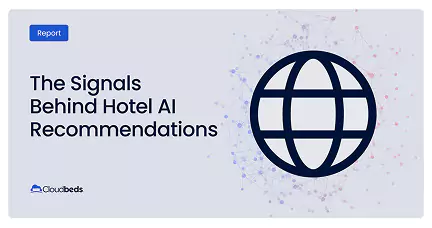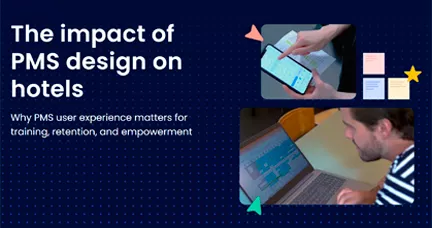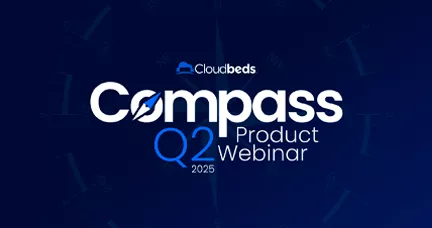
Revenue managers have more data at their fingertips than ever before, but many are still flying blind.
Why? Because most revenue management systems continue to rely heavily on historical PMS data, such as bookings, cancellations, ADR, and occupancy, creating two fundamental problems.
First, forecasting based solely on past data assumes that demand patterns repeat themselves year after year, but this never happens. The market constantly evolves with new signals coming from multiple directions.
Second, because traditional hotel forecasting depends on backward-looking data, it remains static: it jumps directly to predicting a final outcome rather than adapting dynamically throughout the booking window. Without real-time adjustments based on emerging market conditions, hotels end up with reactive pricing instead of strategic optimization.
That’s why a new generation of revenue systems has emerged, designed not only to observe trends but also to understand and act on them in real-time.
In this article, we explore how these systems work and the rich, layered data that powers them.
How modern revenue systems think
Hotel demand forecasting must go beyond this outdated approach and complement historical data with real-time and forward-looking insights, identifying trends as they emerge or before they even begin. This shift demands the ability to process substantially more data than before, and a new analytical approach.
This is where causal AI comes in.
Unlike correlation-based AI, which detects patterns in historical data, causal AI processes wider datasets using algorithms that uncover true cause-and-effect relationships. When those subtle relationships are missed, accuracy suffers, and revenue forecasts can be seriously led astray.
For example, if bookings suddenly surge, a traditional system could attribute that to a recent rate drop. Causal AI might reveal that the real driver was a local event or a spike in inbound flight demand. That level of insight allows revenue teams not just to adjust pricing, but to trigger strategic actions like launching a targeted promotion, boosting OTA visibility, or reallocating marketing budget to capitalize on new demand.
Cloudbeds Revenue Intelligence, powered by Signals, uses causal AI to detect these drivers and recommend specific, revenue-impacting actions across pricing, distribution, and marketing.
It maintains 95% forecast accuracy even during disruptions, seasonal anomalies, or when entering new markets, environments where traditional systems often fail.
Forecast with up to 95% accuracy.
Move faster than ever before with Cloudbeds Revenue Intelligence.
The data sources powering modern revenue management
In addition to PMS data, Signals analyzes 4 billion data points per hour from third- and first-party sources to deliver real-time recommendations. Each of these sources plays a role in helping hotels adjust pricing, shift strategy, or trigger targeted marketing actions.
Here’s a closer look at the core data types fueling Cloudbeds Revenue Intelligence:
Competitors’ rates
Real-time data scraped from OTAs and competitors’ websites reveals under- or overpriced dates. This enables smarter decisions about when to undercut competitors or confidently hold or raise rates.
Market demand signals
Powerful demand indicators like search data from OTAs and metasearch sites, as well as flight booking data, are merged with booking engine data. These forward-looking signals allow teams to anticipate compression, adjust pacing, and evaluate the likely outcome of pricing or promotional changes.
Visibility data
The system shows when to enhance visibility on OTAs during low demand, and when to stop visibility boosters when demand rises, to avoid paying unnecessary commissions during high-demand periods.
Guest reviews and scores
Changes in guest sentiment and review scores affect perceived value and conversion rates. These insights help understand how price changes will perform in context—e.g., if you’ve recently improved ratings while a competitor dropped, you may be able to justify a higher rate.
Event and holiday calendars
These known demand drivers improve forecasting, as they capture not only event nights but also shoulder dates that might otherwise be overlooked.
Corporate and group data
Causal AI analyzes corporate and group booking patterns at the hotel level (your own data), compset level (performance of similar nearby hotels), and market level (citywide or regional demand).
This layered view helps hotels spot shifts in business and group travel trends early and adjust pricing and strategy accordingly.
What this data unlocks for revenue teams
The wealth of integrated data provides hotel teams with powerful new capabilities:
1. Granular visibility
Drill into individual stay dates or zoom out to analyze trends across weeks, months, or seasons. This level of precision helps uncover hidden patterns and optimize performance at both strategic and tactical levels.
2. A unified view of the past, present, and future
Instead of jumping between separate reports for historical performance, current bookings, and forecasts, revenue managers get a unified view, seeing how past decisions affect current performance and how current conditions will impact future outcomes.
3. Early detection of low-demand and high-opportunity dates
The system flags under- or over-performing dates relative to forecasted demand. This empowers teams to act early, adjusting rates, activating promotions, or launching targeted marketing campaigns before it’s too late.
4. See the “why” beyond recommendations
Revenue managers receive reliable recommendations backed by logical reasoning. Instead of a static number (“$199 for June 15”), the system explains both the “why” and the projected impact.
For example: “Recommend $199 for June 15 (up from $179) due to competitor rate increases and 25% higher search volume than typical.”
5. Competitive context that goes beyond rate comparisons
Rather than just knowing your rate is $20 higher than a competitor’s, revenue managers can understand whether that premium is justified based on review scores, amenities, and other factors affecting guest willingness to pay.
Unlock optimal profitability.
Discover strategies to adjust pricing and shift strategies.
A real-world scenario
When the Mercure London Paddington began seeing a decline in bookings, the team turned to Cloudbeds Revenue Intelligence to understand what was happening and how to fix it. Instead of reacting late or cutting rates across the board, the system flagged the issue in advance and recommended precise actions based on causal drivers.
Causes: Three hidden causal variables
First, the hotel was overconfident in a local event’s ability to fill rooms, keeping rates static while competitors were actively dropping theirs.
Second, competitors were enhancing their visibility while Mercure maintained the status quo.
Third, AI highlighted a surge of negative reviews actively deterring potential bookings.
Actions: A three-stage recovery plan
- Smarter retargeting. Re-targeting website visitors with time-sensitive deals, rather than sending the traditional “book now” email to everyone in the contact list.
- Audience activation across key channels. Leveraging Google and Meta to activate audiences with travel intent, specifically located along train lines coming into Paddington. These audiences are lookalike to the traffic arriving on the hotel website organically.
- Perk-based personalization offers. Rather than simply cutting rates, the hotel created perk-based personalized promotions (early check-in, romance packages, museum passes) to appeal to staycation travelers.
The results
Mercure Paddington reached 93% occupancy (vs. 64% compset average) and a £120 RevPAR (vs. £79 compset average), which was a complete turnaround powered by explainable insights and targeted action.
The rise of predictive hospitality
Today’s most advanced revenue systems analyze cause-and-effect relationships to uncover the why behind every booking trend. Built on scientific modeling and hospitality-specific data, Cloudbeds Revenue Intelligence gives revenue teams explainable insights, not just numbers, and empowers them to act with greater confidence.
For revenue managers, this means higher confidence in their decisions, reduced decision fatigue, and more time spent on strategy instead of spreadsheets. With this approach, hotels see an average 18% increase in RevPAR within 90 days.
One of the most exciting shifts is how these insights are helping revenue and marketing functions merge into a single, unified commercial strategy, one powered by real-time data, shared goals, and predictive intelligence.
As Cloudbeds’ CEO, Adam Harris explains in an interview with Hospitalitynet:
We want to feel at home when we’re traveling. And at the end of the day, I think why we’re so excited about predictive hospitality is that the data is human. This is an industry that’s based on human-to-human contact, so the more we can understand who the human is through data signals, the better we can be human and bring that hospitality edge.
Built for hotels that demand more.
Cloudbeds Revenue Intelligence analyzes billions of data points.



